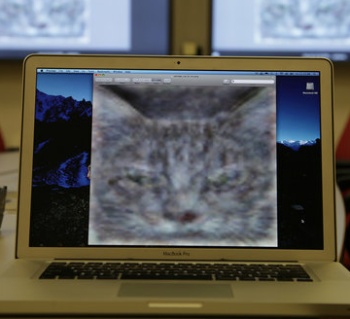Google engineers claim they've designed a computer network capable of analyzing, categorizing and ultimately teaching itself to recognize the content of images. The "neural network" was fed 10 million images from YouTube video thumbnails and – without being told how – created its own concept of what a cat is.
In fact, programmers found that the system had created a fuzzy, dream-like image of a cat's face from scratch (pictured to the right) as at least one generic reference used for identifying felines.
"We never told it during the training, 'This is a cat,' " said Dr. Dean, who originally helped Google design the software that lets it easily break programs into many tasks that can be computed simultaneously. "It basically invented the concept of a cat. We probably have other ones that are side views of cats."
Source: nytimes.com
Along with its keen sense for identifying lolcats, the cluster of 1000 computers (16,000 CPU cores) did a fine job recognizing faces and body parts. Since all of the images originated from 200x200 pixel YouTube thumbnails, it is reasonable to assume the system has also developed a solid concept of "cleavage" and "Justin Bieber", too.
Despite being powered by 16,000 cores, it still took three days to complete the analysis of 10 million thumbnails. However, the results produced by Google's "brain" were nearly twice as accurate as previous attempts.
Image and facial recognition is nothing new. Google's Picasa photo organizing software, for example, does a surprisingly good job at analyzing the faces of your friends. In applications like Picasa though, programmers had to explicitly define what to look for when trying to programmatically separate faces. If what Google researchers say is true, this new system is capable of drawing its own distinctions.
Although researchers were cautious about drawing such parallels, they found that the collection of processors, memory, algorithms and cabling bore an undeniable similarity to its biological analogue – a brain.
"A loose and frankly awful analogy is that our numerical parameters correspond to synapses," Dr. Andrew Ng said. "It is worth noting that our network is still tiny compared to the human visual cortex, which is a million times larger in terms of the number of neurons and synapses".
